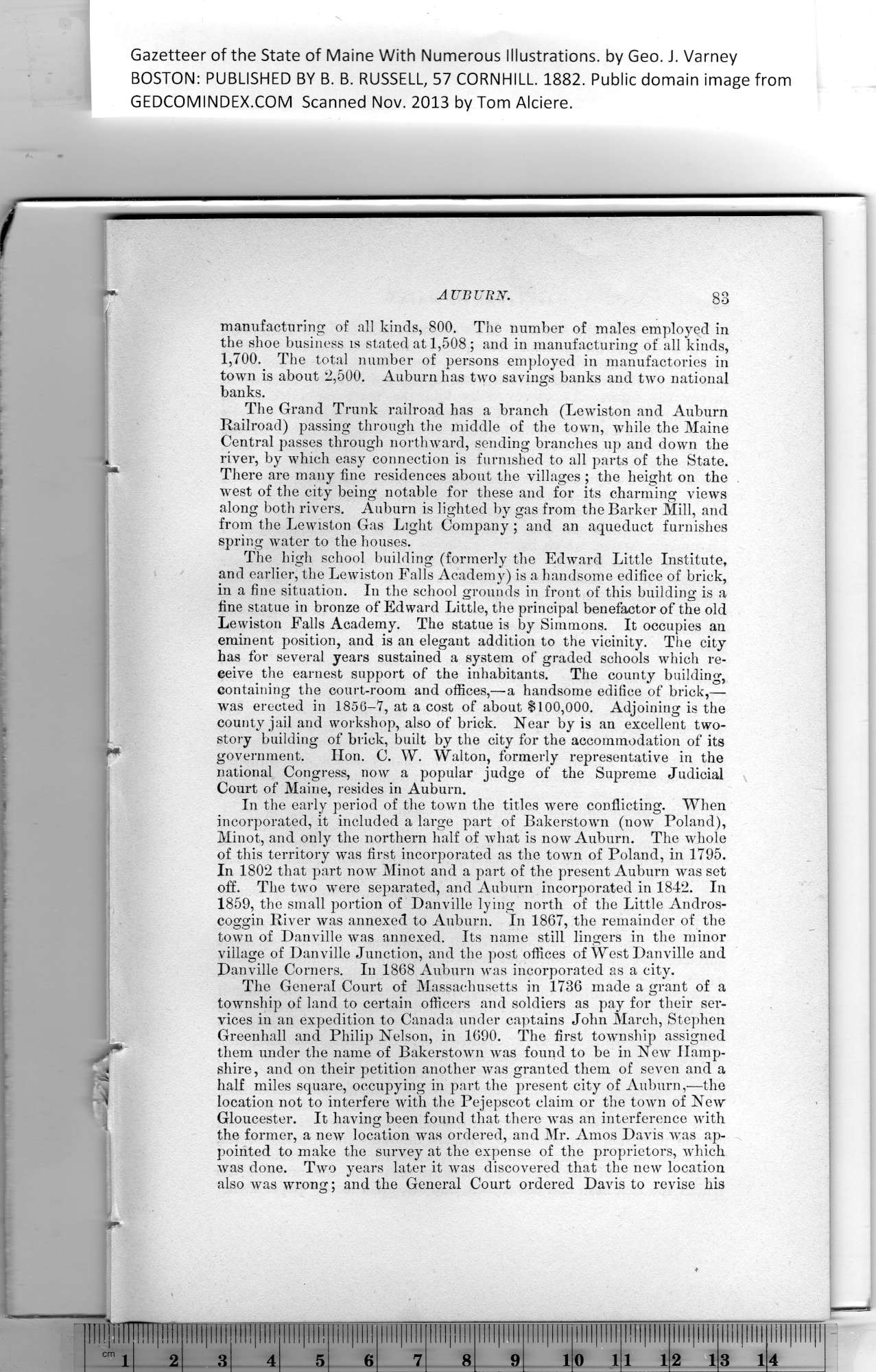|
Gazetteer of the State of Maine With Numerous Illustrations, by Geo. J. Varney
BOSTON: PUBLISHED BY B. B. RUSSELL, 57 CORNHILL. 1882. Public domain image from
AUBURN. 83
^ manufacturing of all kinds, 800. The number of males employed in
the shoe business is stated at 1,508 ; and in manufacturing of all kinds,
1,700. The total number of persons employed in manufactories in
town is about 2,500. Auburn has two savings banks and two national
banks.
The Grand Trunk railroad has a branch (Lewiston and Auburn
Railroad) passing through the middle of the town, while the Maine
Central passes through northward, sending branches up and down the
% river, by which easy connection is furnished to all parts of the State.
There are many fine residences about the villages ; the height on the
west of the city being notable for these and for its charming views
along both rivers. Auburn is lighted by gas from the Barker Mill, and
from the Lewiston Gas Light Company; and an aqueduct furnishes
spring water to the houses.
The high school building (formerly tbe Edward Little Institute,
and earlier, the Lewiston Falls Academy) is a handsome edifice of brick,
in a fine situation. In the school grounds in front of this building is a
fine statue in bronze of Edward Little, the principal benefactor of the old
Lewiston Falls Academy. The statue is by Simmons. It occupies an
eminent position, and is an elegant addition to the vicinity. The city
has for several years sustained a system of graded schools which re-
ceive the earnest support of the inhabitants. The county building,
containing the court-room and offices,—a handsome edifice of brick,—
was erected in 1856-7, at a cost of about $100,000. Adjoining is the
county jail and workshop, also of brick. Near by is an excellent two-
story building of brick, built by the city for the accommodation of its
government. Hon. C. W. Walton, formerly representative in the
national Congress, now a popular judge of the Supreme Judicial
Court of Maine, resides in Auburn.
In the early period of the town the titles were conflicting. When
incorporated, it included a large part of Bakerstown (now Poland),
Minot, and only the northern half of what is now Auburn. The whole
of this territory was first incorporated as the town of Poland, in 1795.
In 1802 that part now Minot and a part of the present Auburn was set
off. The two were separated, and Auburn incorporated in 1842. In
1859, the small portion of Danville lying north of the Little Andros-
coggin River was annexed to Auburn. In 1867, the remainder of the
town of Danville was annexed. Its name still lingers in the minor
village of Danville Junction, and the post offices of West Danville and
Danville Corners. In 1868 Auburn was incorporated as a city.
The General Court of Massachusetts in 1736 made a grant of a
township of land to certain officers and soldiers as pay for their ser-
vices in an expedition to Canada under captains John March, Stephen
Greenhall and Philip Nelson, in 1690. The first township assigned
/^' them under the name of Bakerstown was found to be in New Hamp-
shire, and on their petition another was granted them of seven and a
half miles square, occupying in part the present city of Auburn,—the
i location not to interfere with the Pejepscot claim or the town of New
^ Gloucester. It having been found that there was an interference with
the former, a new location was ordered, and Mr. Amos Davis was ap-
pointed to make the survey at the expense of the proprietors, which
was done. Two years later it was discovered that the new location
also was wrong; and the General Court ordered Davis to revise his
PREVIOUS PAGE ... NEXT PAGE
This page was written in HTML using a program written in Python 3.2
| 